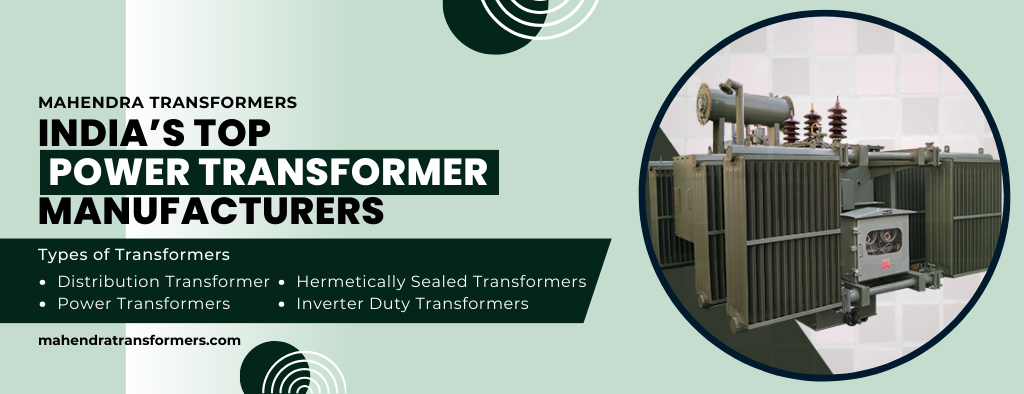Top 5 Power Transformer Manufacturers, Company in India

Power transformers are essential components in the electrical grid, responsible for stepping up or stepping down voltage levels to ensure efficient power transmission and distribution. They play an important role in maintaining the stability and reliability of power systems. As such, Power Transformer Manufacturers are pivotal in the energy sector, providing the critical infrastructure needed to meet global electricity demands. This blog explores the role of Power Transformer Manufacturers, their impact on modern energy systems, and the key factors influencing their operations.
What is Power Transformers?
Before delving into the role of manufacturers, it’s important to understand what power transformers are and how they function. Power transformers are electrical devices designed to transfer electrical energy between two or more circuits through electromagnetic induction. They consist of primary and secondary windings wrapped around a core. The primary winding receives an input voltage, which is then transformed by the core and transferred to the secondary winding, delivering the output voltage.
Transformers are classified based on various factors, including their cooling methods (oil-immersed or Inverter Duty), their configuration (single-phase or three-phase), and their application (distribution or power transformers). Each type of transformer is designed to meet specific requirements in terms of efficiency, capacity, and environmental conditions.
The Role of Power Transformer Manufacturers
Power Transformer Manufacturers are crucial in ensuring that these devices are designed, produced, and maintained to meet the demands of modern electrical grids. Their role can be broken down into several key areas:
1. Design and Innovation
Manufacturers invest heavily in research and development (R&D) to improve transformer efficiency, reliability, and performance. Innovations in transformer design can lead to enhanced energy efficiency, reduced losses, and improved operational lifespan. For instance, advancements in core materials, such as amorphous steel, can significantly reduce core losses. Manufacturers are also exploring new technologies like smart transformers, which integrate digital monitoring and control capabilities to enhance grid management.
2. Production and Quality Assurance
The production process of power transformers involves complex engineering and precision manufacturing. Manufacturers must adhere to strict quality standards to ensure that transformers operate safely and reliably under various conditions. Quality assurance includes rigorous testing of materials, components, and final assemblies. Key tests include insulation resistance tests, transformer impedance tests, and thermal performance evaluations.
3. Customization and Integration
Power transformers are not one-size-fits-all. Manufacturers often work closely with utility companies, industrial clients, and other stakeholders to design and produce customized transformers tailored to specific applications. This includes adjusting voltage ratings, capacity, and cooling methods to meet particular requirements. Additionally, transformers need to be integrated into existing systems, which requires collaboration with engineers and planners to ensure seamless operation.
4. Maintenance and Support
Once installed, power transformers require ongoing maintenance to ensure optimal performance and longevity. Manufacturers provide support services, including routine inspections, repairs, and upgrades. Effective maintenance strategies can prevent unexpected failures and extend the life of the transformer, which is crucial for maintaining grid reliability.
5. Regulatory Compliance and Environmental Considerations
Power Transformer Manufacturers must comply with various international and local regulations related to safety, environmental impact, and energy efficiency. This includes adhering to standards set by organizations such as the International Electrotechnical Commission (IEC) and the Institute of Electrical and Electronics Engineers (IEEE). Manufacturers also need to address environmental concerns, such as minimizing the use of harmful materials and ensuring proper disposal of transformer fluids.
Impact on Modern Energy Systems
Power Transformer Manufacturers have a significant impact on modern energy systems, influencing various aspects of electricity generation, transmission, and distribution.
1. Enhancing Grid Reliability
Reliable power delivery is essential for the stability of electrical grids. Power transformers play a key role in stepping up voltage for long-distance transmission and stepping down voltage for local distribution. High-quality transformers ensure that voltage levels remain within acceptable limits, reducing the risk of outages and system failures.
2. Supporting Renewable Energy Integration
The integration of renewable energy sources, such as wind and solar, into the grid presents unique challenges. Power transformers are used to connect renewable energy systems to the grid, often requiring specialized designs to handle variable outputs and high levels of harmonics. Manufacturers are developing transformers that can support these new energy sources and facilitate the transition to a more sustainable energy system.
3. Facilitating Electrification
The global trend towards electrification, including the adoption of electric vehicles (EVs) and the expansion of electric heating and cooling systems, increases the demand for electrical infrastructure. Power Transformer Manufacturers contribute to this trend by providing transformers that support higher power capacities and accommodate the growing demand for electricity.
4. Improving Efficiency and Reducing Losses
Efficiency is a key concern in power systems. Power transformers are designed to minimize energy losses during voltage conversion. Innovations in transformer technology, such as improved core materials and advanced cooling techniques, help reduce losses and enhance overall system efficiency. This is important not only for reducing operational costs but also for minimizing the environmental impact of power generation.
5. Supporting Technological Advancements
The advancement of technologies such as smart grids and advanced monitoring systems relies on the integration of modern transformers. Smart transformers equipped with sensors and communication technology enable real-time monitoring and control, which enhances grid management and allows for more responsive and adaptive energy systems.
Challenges Faced by Power Transformer Manufacturers
Power Transformer Manufacturers face several challenges that impact their operations and the broader energy sector.
1. Raw Material Costs
The cost of raw materials, such as copper, steel, and insulating oils, can fluctuate significantly. Manufacturers must manage these costs while maintaining competitive pricing and ensuring high-quality products. Market volatility in raw materials can affect production costs and, consequently, the pricing of transformers.
2. Technological Evolution
As technology advances, manufacturers must continuously innovate and adapt their designs to stay competitive. This requires significant investment in R&D and the ability to quickly incorporate new technologies into production processes. Staying ahead of technological trends is crucial for maintaining a competitive edge.
3. Regulatory and Environmental Compliance
Compliance with evolving regulations and environmental standards can be challenging. Manufacturers must navigate complex regulatory environments and ensure that their products meet safety, efficiency, and environmental criteria. This often involves additional costs and operational adjustments.
4. Global Supply Chain Management
Power transformer manufacturing involves a global supply chain, with components sourced from various locations. Managing this supply chain efficiently is essential to avoid delays and ensure the timely delivery of transformers. Supply chain disruptions, such as those caused by geopolitical tensions or natural disasters, can impact production schedules and costs.
5. Market Competition
The power transformer industry is highly competitive, with numerous manufacturers operating globally. Competition drives innovation but also puts pressure on manufacturers to reduce costs and improve product quality. Differentiating themselves in the market requires a focus on technological advancements, customer service, and reliability.
List of Top 5 Power Transformer Manufacturers in India
Several major companies are prominent in the power transformer manufacturing industry. These companies are known for their expertise, innovation, and global presence.
1. Mahendra Transformers
Mahendra Transformers is a leading global Power Transformer Manufacturers & Suppliers in India, offering a wide range of products for various applications. The company is known for its commitment to innovation and sustainability, with a focus on developing advanced transformer technologies and smart grid solutions.
2. General Electric (GE)
GE is another major player in the power transformer market, providing transformers for transmission, distribution, and industrial applications. GE’s transformers are designed to meet rigorous performance standards and are supported by a global network of service and support.
3. Schneider Electric
Schneider Electric specializes in energy management and automation solutions, including power transformers. The company focuses on integrating digital technologies to enhance transformer performance and support the transition to a more sustainable energy system.
4. ABB
ABB is a global leader in power and automation technologies, including power transformers. ABB’s transformers are known for their reliability, efficiency, and innovative features. The company is also involved in developing solutions for renewable energy integration and smart grid technologies.
5. Mitsubishi Electric
Mitsubishi Electric is a prominent manufacturer of power transformers with a strong emphasis on quality and performance. The company offers a range of transformers designed for various applications, including high-voltage and industrial settings.
Future Trends in Power Transformer Manufacturing
The power transformer industry is evolving rapidly, driven by technological advancements and changing energy demands. Some key trends shaping the future of power transformer manufacturing include:
1. Smart Transformers
The integration of digital technologies into transformers is enabling smarter grid management and enhanced performance. Smart transformers equipped with sensors and communication capabilities allow for real-time monitoring, diagnostics, and control, improving grid reliability and efficiency.
2. Eco-Friendly Materials
There is a growing emphasis on using environmentally friendly materials and reducing the environmental impact of transformer production and operation. Manufacturers are exploring alternative insulating materials, such as biodegradable fluids, and developing transformers with lower carbon footprints.
3. Renewable Energy Integration
As the share of renewable energy sources in the grid increases, power transformers must be designed to handle the unique characteristics of these sources. This includes managing variable outputs and harmonics, as well as facilitating the integration of distributed generation.
4. Increased Efficiency
Ongoing efforts to improve transformer efficiency focus on reducing energy losses and optimizing performance. Advances in core materials, cooling technologies, and design methodologies contribute to enhanced efficiency and lower operational costs.
5. Modular and Scalable Designs
Modular and scalable transformer designs are becoming more common, allowing for easier expansion and adaptation to changing energy needs. These designs enable utilities and industrial users to adjust capacity and functionality as required, providing greater flexibility and cost-effectiveness.
Conclusion
Power Transformer Manufacturers play a critical role in the electrical industry, providing the infrastructure necessary to ensure reliable and efficient power delivery. Their contributions span across design, production, maintenance, and innovation, impacting various aspects of modern energy systems. As the energy landscape continues to evolve, manufacturers will.
--------------------------------
Guestbeat.com Notice!
Audience discretion is needed, Read TOS.
Submit Guest Post / Read Latest / Category List
App & Rate-Us / Subscribe Daily Newsletter (FREE)



